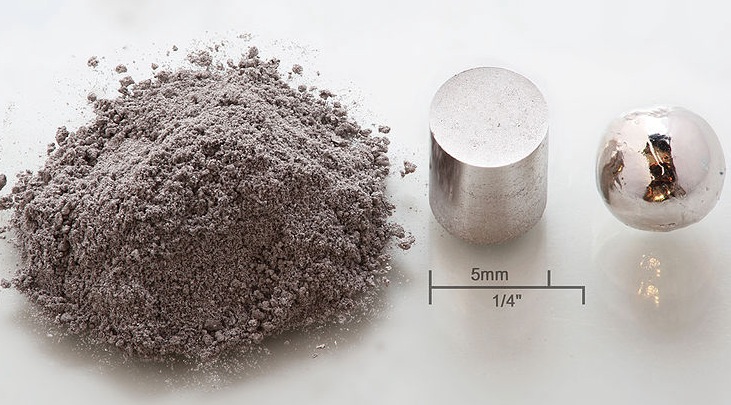Rhodium

Rhodium
Image by Alchemist-hp - source Wikpedia - lic. under CC 3.0
Rhodium - overview
Rhodium is one of the six platinum group metals (the others are iridium, osmium, palladium, platinum and ruthenium.) [1]
Rhodium was discovered by William Hyde Wollaston in 1804 and is produced today as a by-product of platinum refining and nickel mining. [2] It is one of the scarcest elements and the most expensive of the precious metals. Rhodium is hard, durable, has a higher melting point than platinum and is extremely resistant to corrosion. Annual production is around 25 tons. [1]
The industrial processing and purification of rhodium is challenging. It is found in ores chiefly mined for other metals, which are extracted first - and then it is separated using a complex multi-stage chemical process. [3]
Rhodium Resources and Production
The greatest producer of rhodium today is South Africa which produces almost 60% of the world's rhodium supply, with Russia second. Instability in the supply of Rhodium has caused major price fluctuation in the past 20 years. Rhodium is also produced in the USA.
Rhodium Uses
The use for which rhodium is perhaps most famous is as an element in automobile catalytic converters. 81% of the rhodium used by industry in 2007 goes towards this use - and in the last few years the recycling of catalytic converters has become an important source of rhodium for industry, with approx. 20% of rhodium supplied being from recycled sources. [1]
Rhodium is also used to make other types of catalyst, such as those used in acetic acid, cyclohexane and silicone rubber manufacture. [1]
One of most significant uses of rhodium is as a hardening agent in platinum and palladium alloys. [4] These are used for example in thermocouple elements and furnace windings, aircraft spark plug electrodes, the glass industry and laboratory crucibles.
Rhodium is also used as a plating in optical instruments due to its hardness, and in pen nibs.
Rhodium is used in jewelry making. It is plated onto white gold, silver and platinum jewelry in order to give the metals a shiny, durable surface - and in the case of silver to protect it from tarnishing. Rhodium is highly reflective and non-tarnishing, with the result that it is also used in finishings for mirrors and search lights. [5]
Rhodium prices soared to over $10,000 per troy ounce in 2008 - bringing the metal a new wave of fame. This price was partly pushed by power failures in South Africa which caused temporary shutdown of mining, and subsequent fears over supply reliability. [6] However, due to global economic slowdown and in particular the declines in new car purchases since then, prices fell sharply in 2008, recovering somewhat since then.
Other platinum group metals can be used in automotive catalysts, but rhodium evidently works better. Use of rhodium seems stable in many areas - but innovations in engine technology (for example, electric cars) could affect demand in the future. Critical factors affecting the future price of rhodium could include interruptions in supply, and automobile technology.
Rhodium Facts
| Name | Rhodium |
| Symbol | Rh |
| Atomic Number | 45 |
| Melting point (Celsius) | 1964ºC |
| Density | 12.45 g/cc |
| Hardness (Moh) | 6.0 |
| Resistivity (nanoOhms / meter at 20ºCelsius) | 43.3 |
Rhodium References:
[1] http://en.wikipedia.org/wiki/Rhodium
[2] http://www.district196.org/shms/staff/siefkes_t/periodic_table/rhodhium/uses.html
[3] http://www.hcrosscompany.com/precious/rhodium.htm
[4] http://www.platinummetalsreview.com/jmpgm/index.jsp
[5] http://www.kitco.com/charts/rhodium.html
[6] http://minerals.usgs.gov/minerals/pubs/commodity/platinum/mcs-2009-plati.pdf

This website is not investment advice or a recommendation to buy or sell.


